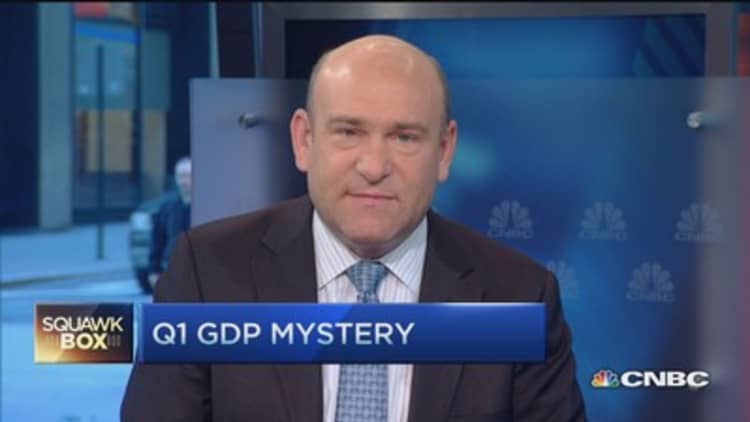
The past two winters, and four of the last five, the U.S. economy ran into a snowbank. Since the economic recovery began in late 2009, professional economists have forecast decent growth at the start of each year, only to see initial reports on gross domestic product fall well short of expectations.
As we finish yet another year when the U.S. economy is projected to be among the strongest in the world, what are the chances it can avoid yet another first-quarter skid?
In the first quarters of 2015 and 2014, the initial, or "advance" estimate of GDP were barely above zero, defying forecasts around 1 percent — forecasts which had already been cut from above 2 percent. One of those reports was revised to an outright decline in economic activity, and the other bumped higher.
But in each case, the apparent slowdowns rattled markets, leading to January pullbacks in stocks and raising fresh concerns about the effectiveness of Federal Reserve policy.
As CNBC's Steve Liesman has thoroughly chronicled, first quarters have been weaker than the rest of the year for decades. Government agencies have been working to tweak some seasonal-adjustment factors that seem to be depressing reported first-quarter growth measures.
It's not yet clear whether this alone will help the economy live up to the cautiously optimistic consensus on early-2016 growth — which is now, once again, seen clocking in at roughly the 2 to 2.5 percent annualized pace that has become the longer-term trend.
Yet there are a few reasons to believe a first-quarter flop is somewhat less likely in 2016. Aside from the work by the Bureau of Economic Analysis to smooth out buggy seasonal factors in the GDP calculation, anticipated warmer weather this year could also support output.
Economists at Bank of America Merrill Lynch point out that this year features a strong El Nino effect, a periodic warming of the Pacific Ocean that typically coincides with higher-than-normal temperatures in much of the U.S. With the El Nino conditions set to be among the most pronounced since 1950, the Merrill economists say an unusually mild winter would "allow for greater housing construction, stronger retail sales and, generally, just more churn in the economy."
This effect could be magnified by the fact that the past two winters were characterized by stretches of atypical deep freezes and severe, transportation-snarling storms.
Beyond the weather itself, "after two cold winters, the seasonal factors will be looking for weakening in the data, which could create an upward bias" to the reported growth numbers. Prior years of strong El Nino influence have shown this pattern playing out, in general.
The conditions in the domestic consumer economy, too, are tilting in the direction of reasonably healthy activity in the coming months. The economy has added some 2.7 million jobs in the past year, the unemployment rate has sunk to 5 percent and personal income has been rising nicely.
While this is a pretty comfortable environment at first glance, the stakes for investors arguably remain pretty high on the question of whether growth comes in near the expected trend pace early next year.
The Fed is now overwhelmingly expected to lift short-term interest rates in mid-December. This would be the first rate hike since 2006, and the first initial cinching-up of rates in more than 11 years.
If the economy were to downshift significantly in the first quarter following such a carefully choreographed move, it would prompt loud charges that the Fed had committed a "policy error," removing stimulus from a still-fragile economy, despite scant evident signs of unwelcome inflation.
CNBC contributor and Lindsey Group's chief market analyst, Peter Boockvar, is among those pointing to the relatively weaker state of the economy today than when the Fed last embarked on a tightening campaign, in 2004. While he favors the Fed getting away from near-zero rates, he argues that further flattening of the yield curve (with two-year yields rising toward steady 10-year yields) would raise questions over the future course of Fed action. "If the bear flattening from here forward continues," he says, "it will say a lot about how the Treasury market thinks the U.S. economy can handle rate hikes."

On the other hand, if domestic-consumer momentum builds and the winter is mild and the government data end up surprising to the upside next quarter, it would undermine the current consensus that after the first rate increase the Fed will pursue a deliberate "low and slow" policy for further tightening.
Already, as Reuters details here, there is a tense debate emerging within Fed policy circles over the trajectory of rate "normalization. An acceleration in GDP would be good for a revival of corporate profits, but would spur investors to rethink how much they're willing to pay for those earnings with a Fed more aggressive than assumed.
Goldman Sachs chief U.S. equity strategist David Kostin is among those suggesting this could be an important storyline of the 2016 markets. In his year-ahead outlook report this week, Kostin predicted another flat year for the S&P 500, in part because economic growth translates to a somewhat quicker pace of rate moves than the markets now anticipate, which would restrain the price-to-earnings multiple of the broad market.
This faster-growth scenario, on balance, would be a pretty good reason for stocks to go sideways for a year — and maybe offers yet another reason to wish for a less nasty winter.




